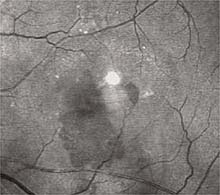Retinal vascular anomalous complex a difficult but not impossible challenge
Some encouraging results have been obtained with direct photocoagulation and transpupillary thermotherapy.
| RVAC
Source: Hartnett ME, Weiter JJ, et al. Deep retinal vascular anomalous complexes in advanced age-related macular degeneration. Ophthalmology. 1996;103:2042-2053. |
MILAN – Retinal vascular anomalous complex can be treated successfully, especially if an early diagnosis is made, according to two specialists.
RVAC, a recently described retinal condition, is usually poorly responsive to the standard treatments administered for age-related macular degeneration. But according to Ferdinando Bottoni, MD, some benefits can be achieved by photodynamic therapy (PDT), or even more by direct photocoagulation if the treatment is applied in the initial stages of the disease. In the experience of Edoardo Midena, MD, transpupillary thermotherapy (TTT) has also shown some encouraging results.
Different treatments
Prof. Bottoni presented a study comparing groups of patients treated for RVAC at different stages and using different treatment modalities between January 2000 and December 2001. The study included 54 patients with a total of 77 lesions.
“For initial, extrafoveal RVAC with a small amount of intra/subretinal fluid, we used either direct laser photocoagulation of the vascular lesion (group 0) or laser photocoagulation of the feeder retinal arteriole (group 1),” he said. “For more developed lesions with a moderate to severe amount of intra/subretinal fluid, we used either grid-like laser photocoagulation (group 2) or PDT (group 3). In case of treatment failure, which was always related to the last two groups, we were allowed to shift to a second or third treatment modality (groups 4 and 5).”
Direct photocoagulation best
The direct laser photocoagulation treatment group achieved the best functional and anatomical results, with a complete obliteration in almost the total amount of cases. Visual acuity, which was a mean 20/30 at baseline, remained stable after the treatment and until the end of the follow-up.
The PDT treatment group was the second most successful, with 7 of 10 cases achieving complete obliteration. Patients lost an average of 1.5 lines of visual acuity at the end of the follow-up. Mean final visual acuity was 20/50.
In the other groups, the success rate in terms of obliteration was less than 50%, and final visual acuity approached 20/200.
“Taking into account that the natural history of this disease leads to a progressive and quite dramatic loss of visual acuity, stabilization or even a slowed-down decrease of visual acuity can be considered a success,” Prof. Bottoni said. “It seems from our figures that initial visual acuity is a very important prognosis factor for final visual acuity. However, the type of treatment is also significantly correlated with final visual acuity.”
So while well-developed intraretinal vascular components are rarely obliterated with either PDT or photocoagulation, retinal vascular complex of recent onset (which is always extrafoveally located) may be successfully treated with laser photocoagulation.
“Dynamic indocyanine green angiography is therefore mandatory, because early diagnosis and subsequently early treatment have shown to increase the success rate in this difficult aging maculopathy,” he added.
|
|
|
|
|
|
TTT
In a homogeneous series of 25 eyes, Prof. Midena tried a different approach with a modified TTT technique, using two consecutive spots of 3 mm and 1.2 mm to close the lesions.
“The treatment is based on the principal of thermal resistance of the retina. The two spots, which are both subthreshold, are superimposed. The slow increase in temperature causes vessel occlusion but is absolutely well-tolerated by the retina,” he said.
Eyes were examined at weeks 1 and 4, then every month after the treatment for a minimum of 6 months. The mean follow-up was 18 months.
After the treatment, 20 of the 25 eyes (80%) showed persistent decrease of leakage. Baseline visual acuity remained stable in all successfully treated eyes and deteriorated in five eyes, which showed disciform scarring. The results were better than any previously reported data, Prof. Midena said.
“These results are only preliminary but seem very encouraging,” he concluded. “There are some tangible benefits in terms of visual acuity preservation, which we have more rarely seen with other types of treatment. Certainly we must be aware that TTT works slowly: we won’t see immediate results, but a progressive improvement.”
For Your Information:
- Ferdinando Bottoni, MD, can be reached at Ospedale San Giuseppe, U.O. di Oculistica, Milan, Italy; +(39) 028-599-4549; fax: +(39) 028-599-4200; e-mail: ferbot@fastwebnet.it.
- Edoardo Midena, MD, can be reached at Clinica Oculistica, Università di Padova, Via Giustiniani 2, 35128 Padua, Italy; +(39) 049-821-2110; fax: +(39) 049-821-2129; e-mail: edoardo.midena@unipd.it.




